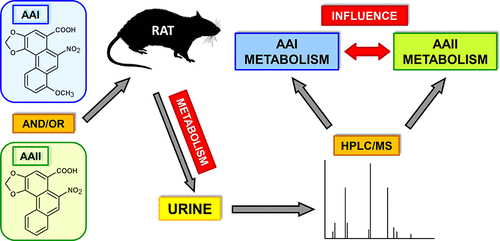当前位置:
X-MOL 学术
›
Chem. Res. Toxicol.
›
论文详情
Our official English website, www.x-mol.net, welcomes your
feedback! (Note: you will need to create a separate account there.)
In vivo metabolism of aristolochic acid I and II in rats is influenced by their co-exposure.
Chemical Research in Toxicology ( IF 3.7 ) Pub Date : 2020-09-07 , DOI: 10.1021/acs.chemrestox.0c00198 Alena Dedı Ková 1 , František Bárta 1 , Václav Martínek 1 , Kevin Kotalík 1 , Šárka Dušková 2 , Jaroslav Mráz 2 , Volker Manfred Arlt 3 , Marie Stiborová 1 , Petr Hodek 1
Chemical Research in Toxicology ( IF 3.7 ) Pub Date : 2020-09-07 , DOI: 10.1021/acs.chemrestox.0c00198 Alena Dedı Ková 1 , František Bárta 1 , Václav Martínek 1 , Kevin Kotalík 1 , Šárka Dušková 2 , Jaroslav Mráz 2 , Volker Manfred Arlt 3 , Marie Stiborová 1 , Petr Hodek 1
Affiliation

|
The plant extract aristolochic acid (AA), containing aristolochic acid I (AAI) and II (AAII) as major components, causes aristolochic acid nephropathy and Balkan endemic nephropathy, unique renal diseases associated with upper urothelial cancer. Differences in the metabolic activation and detoxification of AAI and AAII and their effects on the metabolism of AAI/AAII mixture in the plant extract might be of great importance for an individual’s susceptibility in the development of AA-mediated nephropathies and malignancies. Here, we investigated in vivo metabolism of AAI and AAII after ip administration to Wistar rats as individual compounds and as AAI/AAII mixture using high performance liquid chromatography/electrospray ionization mass spectrometry. Experimental findings were supported by theoretical calculations using density functional theory. We found that exposure to AAI/AAII mixture affected the generation of their oxidative and reductive metabolites formed during Phase I biotransformation and excreted in rat urine. Several Phase II metabolites of AAI and AAII found in the urine of exposed rats were also analyzed. Our results indicate that AAI is more efficiently metabolized in rats in vivo than AAII. Whereas AAI is predominantly oxidized during in vivo metabolism, its reduction is the minor metabolic pathway. In contrast, AAII is mainly metabolized by reduction. The oxidative reaction only occurs if aristolactam II, the major reductive metabolite of AAII, is enzymatically hydroxylated, forming aristolactam Ia. In AAI/AAII mixture, the metabolism of AAI and AAII is influenced by the presence of both AAs. For instance, the reductive metabolism of AAI is increased in the presence of AAII while the presence of AAI decreased the reductive metabolism of AAII. These results suggest that increased bioactivation of AAI in the presence of AAII also leads to increased AAI genotoxicity, which may critically impact AAI-mediated carcinogenesis. Future studies are needed to explain the underlying mechanism(s) for this phenomenon.
中文翻译:

大鼠体内马兜铃酸 I 和 II 的代谢受它们共同暴露的影响。
以马兜铃酸 I (AAI) 和 II (AAII) 为主要成分的植物提取物马兜铃酸 (AA) 会导致马兜铃酸肾病和巴尔干地方性肾病,这是与上尿路上皮癌相关的独特肾脏疾病。AAI 和 AAII 代谢活化和解毒的差异及其对植物提取物中 AAI/AAII 混合物代谢的影响可能对个体在 AA 介导的肾病和恶性肿瘤发展中的易感性具有重要意义。在这里,我们研究了体内使用高效液相色谱/电喷雾电离质谱法以单独的化合物和 AAI/AAII 混合物的形式向 Wistar 大鼠腹膜内给药后 AAI 和 AAII 的代谢。实验结果得到了使用密度泛函理论的理论计算的支持。我们发现暴露于 AAI/AAII 混合物会影响它们在 I 阶段生物转化过程中形成并在大鼠尿液中排泄的氧化和还原代谢物的产生。还分析了在暴露大鼠尿液中发现的几种 AAI 和 AAII 的 II 期代谢物。我们的结果表明,AAI 在大鼠体内比 AAII更有效地代谢。而 AAI在体内主要被氧化代谢,其还原是次要代谢途径。相反,AAII主要通过还原代谢。只有当 AAII 的主要还原代谢物马兜铃内酰胺 II 被酶促羟基化,形成马兜铃内酰胺 Ia 时,才会发生氧化反应。在 AAI/AAII 混合物中,AAI 和 AAII 的代谢受两种 AA 的存在影响。例如,AAI 的还原代谢在 AAII 的存在下增加,而 AAI 的存在降低了 AAII 的还原代谢。这些结果表明,在 AAII 存在下,AAI 的生物活性增加也会导致 AAI 基因毒性增加,这可能会严重影响 AAI 介导的致癌作用。需要未来的研究来解释这种现象的潜在机制。
更新日期:2020-11-16
中文翻译:

大鼠体内马兜铃酸 I 和 II 的代谢受它们共同暴露的影响。
以马兜铃酸 I (AAI) 和 II (AAII) 为主要成分的植物提取物马兜铃酸 (AA) 会导致马兜铃酸肾病和巴尔干地方性肾病,这是与上尿路上皮癌相关的独特肾脏疾病。AAI 和 AAII 代谢活化和解毒的差异及其对植物提取物中 AAI/AAII 混合物代谢的影响可能对个体在 AA 介导的肾病和恶性肿瘤发展中的易感性具有重要意义。在这里,我们研究了体内使用高效液相色谱/电喷雾电离质谱法以单独的化合物和 AAI/AAII 混合物的形式向 Wistar 大鼠腹膜内给药后 AAI 和 AAII 的代谢。实验结果得到了使用密度泛函理论的理论计算的支持。我们发现暴露于 AAI/AAII 混合物会影响它们在 I 阶段生物转化过程中形成并在大鼠尿液中排泄的氧化和还原代谢物的产生。还分析了在暴露大鼠尿液中发现的几种 AAI 和 AAII 的 II 期代谢物。我们的结果表明,AAI 在大鼠体内比 AAII更有效地代谢。而 AAI在体内主要被氧化代谢,其还原是次要代谢途径。相反,AAII主要通过还原代谢。只有当 AAII 的主要还原代谢物马兜铃内酰胺 II 被酶促羟基化,形成马兜铃内酰胺 Ia 时,才会发生氧化反应。在 AAI/AAII 混合物中,AAI 和 AAII 的代谢受两种 AA 的存在影响。例如,AAI 的还原代谢在 AAII 的存在下增加,而 AAI 的存在降低了 AAII 的还原代谢。这些结果表明,在 AAII 存在下,AAI 的生物活性增加也会导致 AAI 基因毒性增加,这可能会严重影响 AAI 介导的致癌作用。需要未来的研究来解释这种现象的潜在机制。










































 京公网安备 11010802027423号
京公网安备 11010802027423号